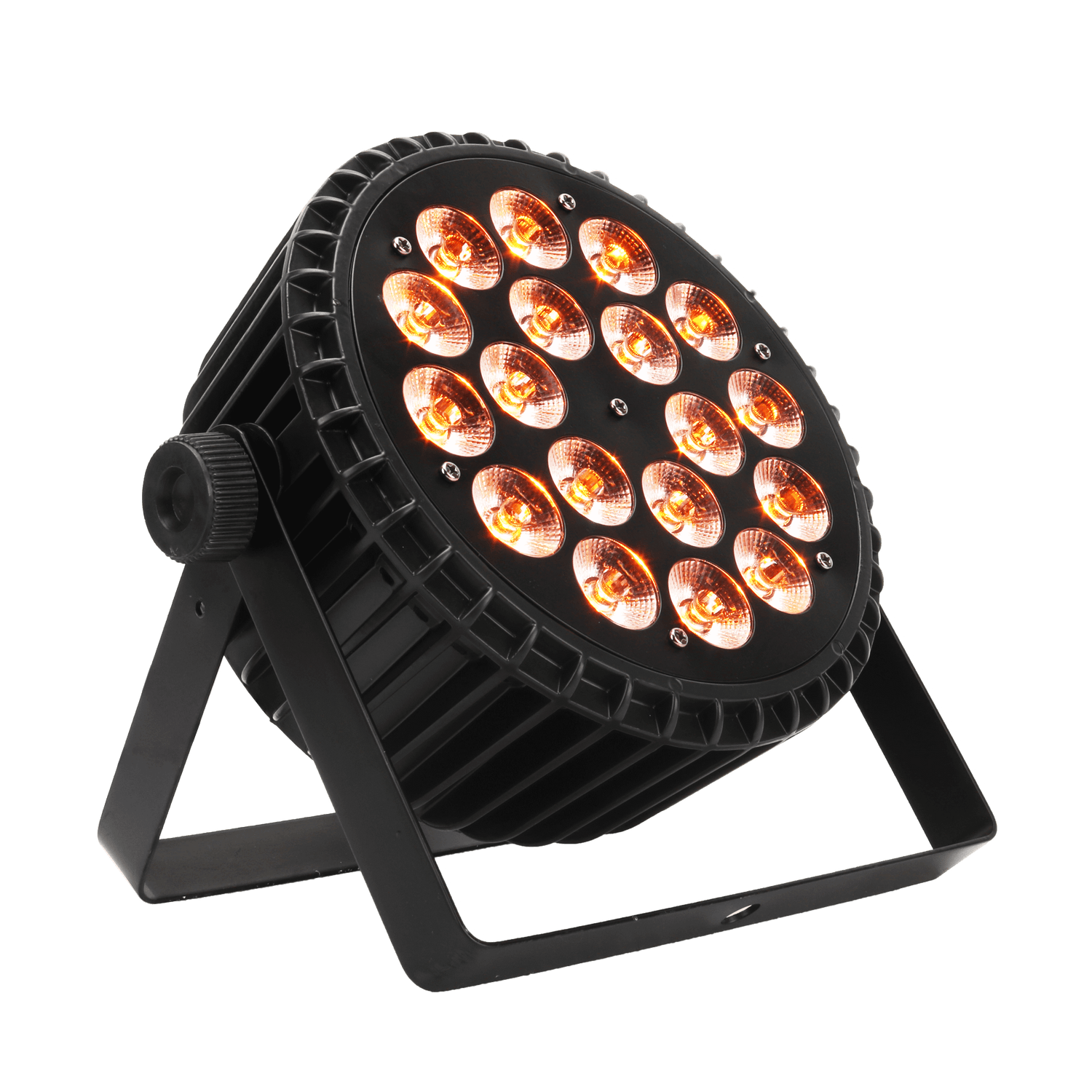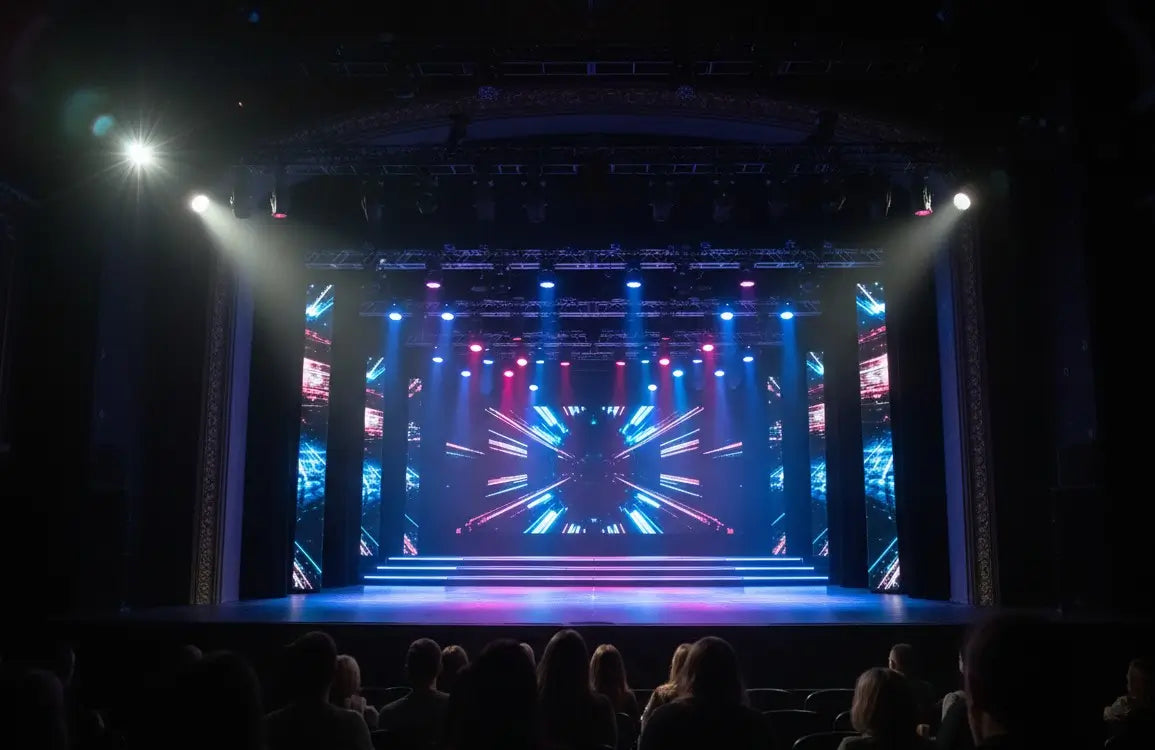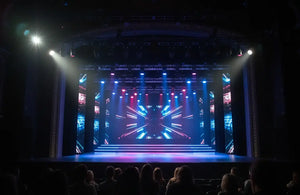Lighting design in the theater goes far beyond simply illuminating performers. It sets the tone, guides focus, and influences the audience’s emotional response.
Thoughtful lighting can shape the atmosphere, indicate the passage of time, and bring out nuances in actors’ performances that might remain invisible without it.
What Is Lighting Design in Theater
Lighting design in theater is the art and technique of shaping how a story feels and looks on stage.
Every spotlight, shadow, and color choice guides the audience’s attention, builds emotion, and defines the mood of a scene.
Here is how lighting design plays a critical role in every stunning theater setup:
- Visibility: It makes sure that the audience can see performers and stage elements clearly.
- Mood: It creates emotion through color, intensity, and shadow.
- Focus: It directs attention to specific characters or areas of the stage.
Beyond these basics, lighting design also enhances storytelling in subtle ways. It can suggest the time of day, indicate location changes, or highlight emotional shifts without a single word of dialogue.
Skilled designers use layers of light to create depth, separating foreground action from background scenery.
Key Types of Theater Lighting
Let’s break down the main types of lighting used in theater—and how Shehds products can help you achieve professional effects at every stage.
1. Spotlights: Directing the Audience’s Eye

Spotlights are the go-to fixtures for focusing attention on key performers, props, or dramatic moments on stage.
Unlike general stage lighting, spotlights provide a precise, controlled beam that isolates the subject from surrounding lights, ensuring the audience’s gaze is guided exactly where the story demands.
They are essential for highlighting emotional close-ups, solo performances, or critical cues in a production.
The Shehds LED 250W LEKO Light is specifically for this purpose. It offers both cool and warm white options, giving designers flexibility to match the mood of a scene.
Its high-precision optics and manual cut system allow clean shaping of the light edges. And this produces sharp spot effects or tightly framed illumination for actors.
In theater productions where subtle storytelling details matter, LEKO spotlights are indispensable for creating focus, depth, and intensity.
2. Wash Lights: Setting the Mood Across the Stage
Wash lights are used to illuminate larger areas of the stage evenly, adding atmosphere, depth, and a base layer of color.
While spotlights isolate, wash lights paint the broader canvas, helping to define scenes, create transitions, and enhance the overall visual impact of a performance.
They are key to establishing the tone of a scene, whether it’s warm and inviting or cool and tense. The Shehds 18x18W Par Lighting is a versatile wash light that allows designers to achieve both soft ambient glows and vivid background colors.
With strong RGBW color mixing and a wide beam angle, it adapts easily to small and medium theater spaces.
For productions that require more color depth, the Shehds 6IN1 RGBAW+UV Par Light adds additional amber and UV tones, offering greater creative flexibility.
Its range of colors enables designers to evoke moods, highlight narrative elements, or accentuate stage decor effectively.
3. Moving Heads: Dynamic Transitions and Effects

Moving head lights introduce motion and versatility to stage lighting. They can pan, tilt, zoom, and change color or intensity dynamically, allowing for smooth scene transitions, dramatic effects, and visually engaging performances.
Moving heads are essential for concerts, musicals, or fast-paced theatrical productions where energy and visual movement are critical.
The Shehds 19x15W RGBW Moving Head combines wash and zoom functions, making it ideal for changing from broad ambient coverage to a tight spotlight on specific performers. Its RGBW
LEDs deliver consistent, vibrant color output, and the flexible zoom range allows designers to emphasize or isolate areas instantly.
For larger stages or more dramatic effects, the Shehds 275W 10R DJ Light adds powerful beam projection and multiple gobo options, perfect for creating striking visual moments during high-energy sequences or scene changes.
4. Wall Wash Lighting: Depth and Texture for the Background
Wall wash lighting enhances depth and texture on stage backdrops, helping scenes feel more immersive and visually rich.
It’s particularly effective for setting spatial context, defining scenery, and supporting mood transitions across the stage. Wall washes often serve as a foundation layer in lighting design, complementing spotlights and moving heads.
The Shehds LED 18x18W RGBWA+UV Wall Wash Lighting provides even color coverage and smooth fades, making it ideal for both modern and classical productions. Its RGBWA+UV system offers precise control over colors and transitions.
This lets lighting designers accentuate scenery, shift atmospheres, or highlight architectural elements on stage.
By adding layers of light to backgrounds, wall wash fixtures create visual depth that strengthens audience engagement and enhances storytelling.
5. Special Effects and Outdoor Productions
For outdoor theater setups or immersive events, lighting fixtures need to withstand environmental challenges like moisture, dust, and unpredictable weather.
Specialized outdoor-rated fixtures ensure consistent performance without risking damage from rain or debris.
The Shehds Waterproof LED 1000W RGB Strobe Moving Head Lighting is built for high-output outdoor use, featuring IP65 protection for full weather resistance.
Its intense beams and strobing effects are perfect for open-air festivals or large-scale stage productions.
For smaller outdoor scenes or partially exposed setups, waterproof outdoor lights offer balanced illumination and reliable color output while staying protected from water and dust.
Both fixtures allow designers to extend theatrical creativity to outdoor environments without compromising visual quality or safety.
Color Theory in Theater Lighting

Source: https://www.youtube.com/watch?v=wqMYsjHU5rU
Color is one of the most powerful storytelling tools in lighting design. Different hues evoke different emotional responses:
Red: Conveys passion, anger, or danger.
Blue: Evokes calmness, isolation, or nighttime scenes.
Amber: Creates warmth, nostalgia, or the feel of candlelight.
Green: Suggests unease, sickness, or mystery.
Purple: Adds a sense of magic, fantasy, or elegance.
White: Highlights clarity, realism, or natural daylight.
UV/Blacklight: Produces surreal, dreamlike, or otherworldly effects
Modern theater lighting systems allow designers to mix colors across the full spectrum with precision, enabling them to craft specific moods and emotional tones for each scene.
Advanced techniques, such as layering colors or incorporating UV lighting, can add depth, highlight dramatic moments, and create surreal or dreamlike effects for more experimental or visually striking performances.
This flexibility makes color a central tool in shaping the audience’s emotional experience.
The Technical Side: DMX and Control Systems
Modern theaters rely on DMX controllers to achieve precise lighting effects and timing. DMX allows every fixture to respond exactly on cue, whether it’s a fade-out, spotlight shift, or color change.
Compatibility with DMX makes it easy to integrate lights into both small setups and large-scale productions.
Smooth dimming and fast response times help lighting operators maintain tight synchronization with music, dialogue, or stage action. Properly configured control systems ensure every lighting cue enhances the performance seamlessly.
All major Shehds products support DMX compatibility. This makes them easy to integrate into both small setups and large-scale productions.
We also offer smooth dimming and fast response times, which help lighting operators maintain tight synchronization with music or dialogue cues.
How to Choose the Right Lights for Theater

Source: https://www.youtube.com/watch?v=wqMYsjHU5rU
Selecting the right theater lighting depends on three main factors: the space, the story being told, and your budget.
For small theaters or school productions, lightweight and versatile fixtures are ideal. They provide professional-quality illumination without consuming excessive power, making them easy to set up and operate.
In larger professional stage setups, it’s important to combine focused spotlights with dynamic effect lights. Spotlights draw attention to key performers, while moving or color-changing lights add depth, transitions, and dramatic impact.
For outdoor or touring shows, durability and weather resistance become critical. Fixtures should handle moisture, dust, and temperature changes while maintaining reliable performance.
The key is to balance creative goals with practical considerations such as power efficiency, control system compatibility, and fixture reliability.
This ensures a visually compelling production that runs smoothly from rehearsal to performance.
Why Choose Shehds for Theater Lighting
Shehds focuses on delivering quality lighting for professional and creative users. Every fixture is designed for performance, consistency, and ease of use. You can rely on:
- Bright, even output that enhances visibility on stage.
- Durable builds for both indoor and outdoor environments.
- DMX support for easy control and cue integration.
- Affordable pricing, especially with the current 12% Halloween promotion on key models.
With products like LED Par lights, you can build a versatile lighting system for any kind of production—from small plays to major festivals.
Final Thoughts
Theater lighting is both creative and precise. It turns a bare stage into a world full of depth and emotion. Light can highlight tension, reveal character, or create atmosphere. Proper design ensures the audience experiences every moment fully.
At Shehds, we give designers that creative freedom—through powerful, flexible, and affordable lighting solutions that make each performance shine brighter.
Explore our full range of stage and theater lighting at shehds.com and bring professional lighting design to your next production.
FAQ
What types of lights are most commonly used in the theater?
The most common types include spotlights, wash lights, moving head lights, wall wash lights, and special effects or outdoor fixtures.
What is the main purpose of lighting design in theater?
Lighting design does more than make performers visible—it establishes the mood, directs audience focus, and enhances storytelling.
Lighting also helps communicate time, place, and emotion, turning every scene into a visual narrative.
How do lighting designers use color to tell a story on stage?
Colors evoke emotion and atmosphere—red for passion or danger, blue for calm or isolation, amber for warmth, green for mystery, and purple for fantasy.
How do you choose the right lighting fixtures for your stage?
Three factors: space size, story tone, and production scale.
- For small venues, compact, multipurpose fixtures like Par Lights offer flexibility.
- Mid to large theaters benefit from a mix of spotlights and moving heads to balance focus and dynamics.
- Outdoor or touring shows require IP65-rated waterproof lights to handle moisture and dust without losing brightness.
How does lighting influence the audience’s emotional response?
Lighting directs what the audience sees and feels. Subtle shifts in brightness or color can build tension, create intimacy, or symbolize emotional transitions.








